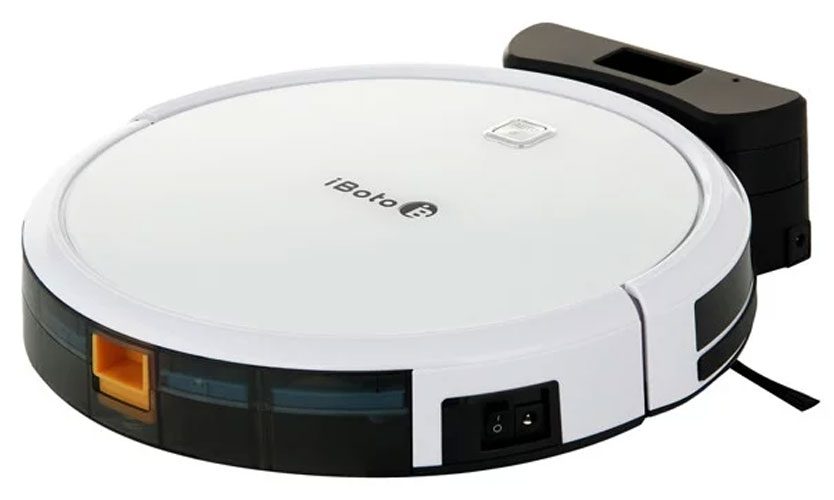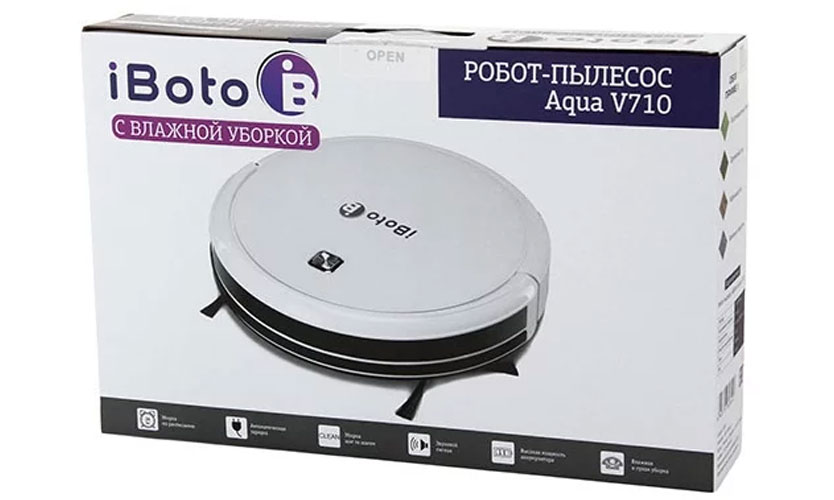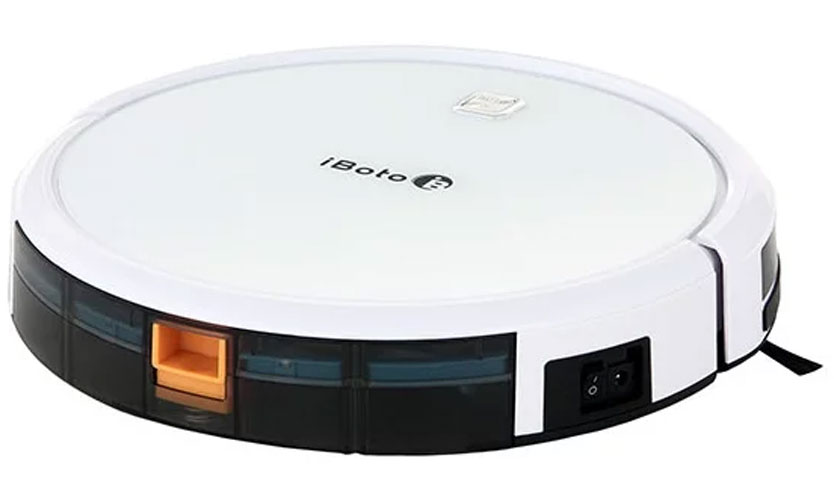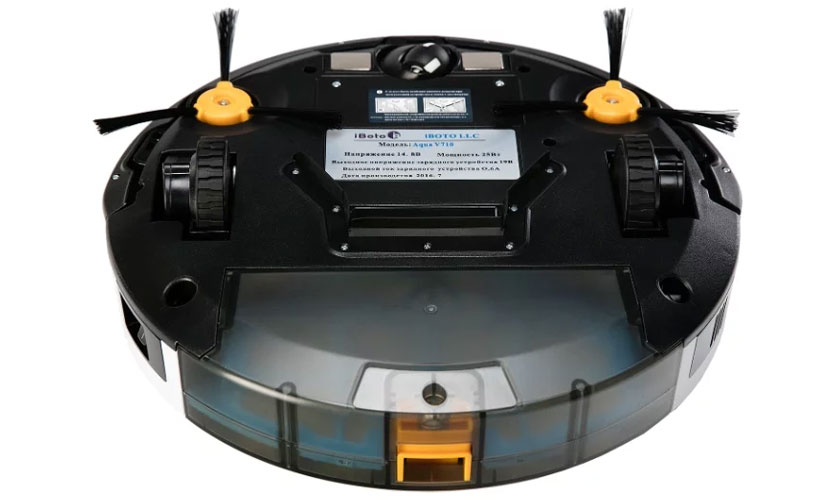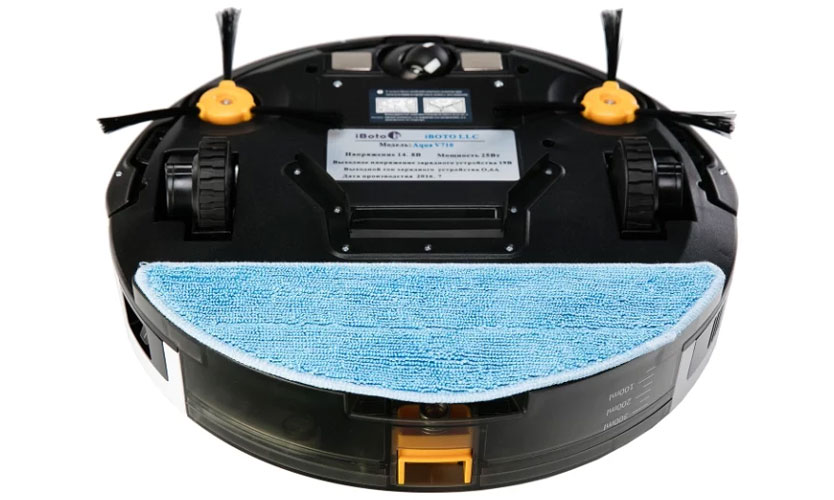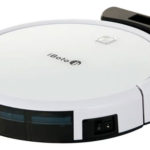One of the most modern and advanced models from the manufacturer, appeared on the market three years ago. It differs from other robotic vacuum cleaners in improved navigation, fully performs dry and wet cleaning. The company's developers took into account all the shortcomings of the cleaning algorithms of previous models, in iBoto Aqua V710 they are improved and more efficient. How well the vacuum cleaner performs its functions, we will analyze below in the review.
Specifications
- Provides dry and wet cleaning.
- Garbage collection in a 400 ml cyclone filter.
- It is completed with a fine filter.
- The Li-lon battery with a capacity of 2600 mAh, enough for 150 minutes of work, I charge for 120 minutes.
- A separate tank is installed for wet cleaning.
- Can be used to collect fluid.
- Automatic installation on the dock.
- Noise level no more than 45 dB.
- Side brush.
- Remote control.
- Soft bumper.
- Height 9 cm.
average cost .
Equipment
- Charging station.
- Power Supply.
- Spare container for wet cleaning.
- Waste bin cleaning brush.
- Spare side brushes.
- Spare HEPA filter.
- Spare microfiber cloth.
- Virtual wall.
- Remote control.
- User's manual.
Design
The body of the vacuum cleaner is in the shape of a perfect circle, the edges are beveled at the bottom for better passage of obstacles. The vacuum cleaner is made of plastic in two colors - white on top and matte black on the bottom. On the upper part there is a panel with a plate made of mineral tempered glass, on it there is a mechanical button with a coating of chrome, when you click on it, the robot starts in automatic mode.
The start button has a backlight showing the current state of the robot: blue - full battery, flashing blue - charging, red - low battery, flashing red - an error. The sound condition of the device is also signaled by sound signals, which cannot be turned off.
The sides of the front and almost the entire circumference are surrounded by a spring-loaded bumper with a slight backlash. On top of the bumper there is a pronounced side, it reduces the likelihood of being stuck under objects with a small height. If the bumper moves slightly, obstacle sensors are triggered. To prevent the robot from damaging interior items during movement, a strip of medium hard rubber is located on its lower part.
A window made of tinted glass is located above the bumper, behind it are hidden IR sensors that detect obstacles, a docking station, a command receiver from the remote control. A similar window is located behind the bumper at the rear of the device.
The garbage container is removed by pressing the yellow latch on the housing at the rear. The waste bin itself is made of tinted plastic, the amount of garbage in it is determined only when the vacuum cleaner is turned over or the container is removed. Inside the container is made very convenient, the front partition is high and does not allow debris to fall out during cleaning. The upper part is hinged, its opening angle is large, even heavy rubbish easily passes.
On the right side are the power connectors for installation on charging, a button for disconnecting the battery from the vacuum cleaner. At the bottom there are contact pads, a front roller wheel for maneuvering, a battery compartment cover, two side brushes, an opening for sucking up garbage, rubber scrapers along its rim. The movement is carried out by a pair of driving wheels. At the front, closer to the bottom edge, are three IR sensors that detect height differences.
Functional
The vacuum cleaner has a modest size, but it has rich functionality. One of its main differences from competitors is full wet cleaning. A separate container is used for it, into which water is filled with detergent. During cleaning, a dosed amount of water is supplied to the rag. First, the robot collects all the garbage using the standard dry cleaning method, and then wipes the floor like a mop.
The robot has several modes of operation:
- Automatic - chaotic movement around the room, cleans along the baseboards and in the corners, in this mode the vacuum cleaner passes around the perimeter several times. At the end of work, he returns to the base.
- Manual mode - control from the remote control in manual mode.
- Intensive cleaning - carried out in one area that needs to be removed. The robot is manually installed in this area. To start cleaning, you need to press the button with a symbol resembling a sight.
- Cleaning in one room - it is turned on by a button with the image of a house and a snake in it, the device removes the necessary time, and then stops.
- Movement along the walls - the robot walks around the perimeter of all walls and obstacles.
Increased suction power is available, it is started by pressing the Max button on the remote control. There is a function of programming a cleaning schedule for every day for a certain time. The included virtual wall limits the cleaning space.
During movement, the intelligent vacuum cleaner system detects the level of contamination and automatically sets the power necessary for operation. When performing wet cleaning, the engine turns off, the speed of the side brushes decreases.
Another important difference between the vacuum cleaner and other models is that it does not have drum brushes. The navigation system consists of 12 sensors, they provide good maneuverability and minimize collisions with objects.
Advantages and disadvantages
You can highlight the list of advantages that a vacuum cleaner has:
- Full wet cleaning.
- Good ratio of price, quality and quantity of the offered functions.
- Manually or automatically adjustable suction power.
- Two-level litter collection systems.
- Separate container for wet cleaning.
- Low noise.
- Tempered glass on the top panel.
- The water tank is protected against leaks.
- Nice kit.
- Thoughtful and working navigation system.
- Small obstacles pass well.
He also has disadvantages:
- Wet cleaning starts only after dry.
- There are no drum brushes, which reduces the efficiency of work on carpeting and when cleaning animal hair.
See also: robots vacuum cleaners up


